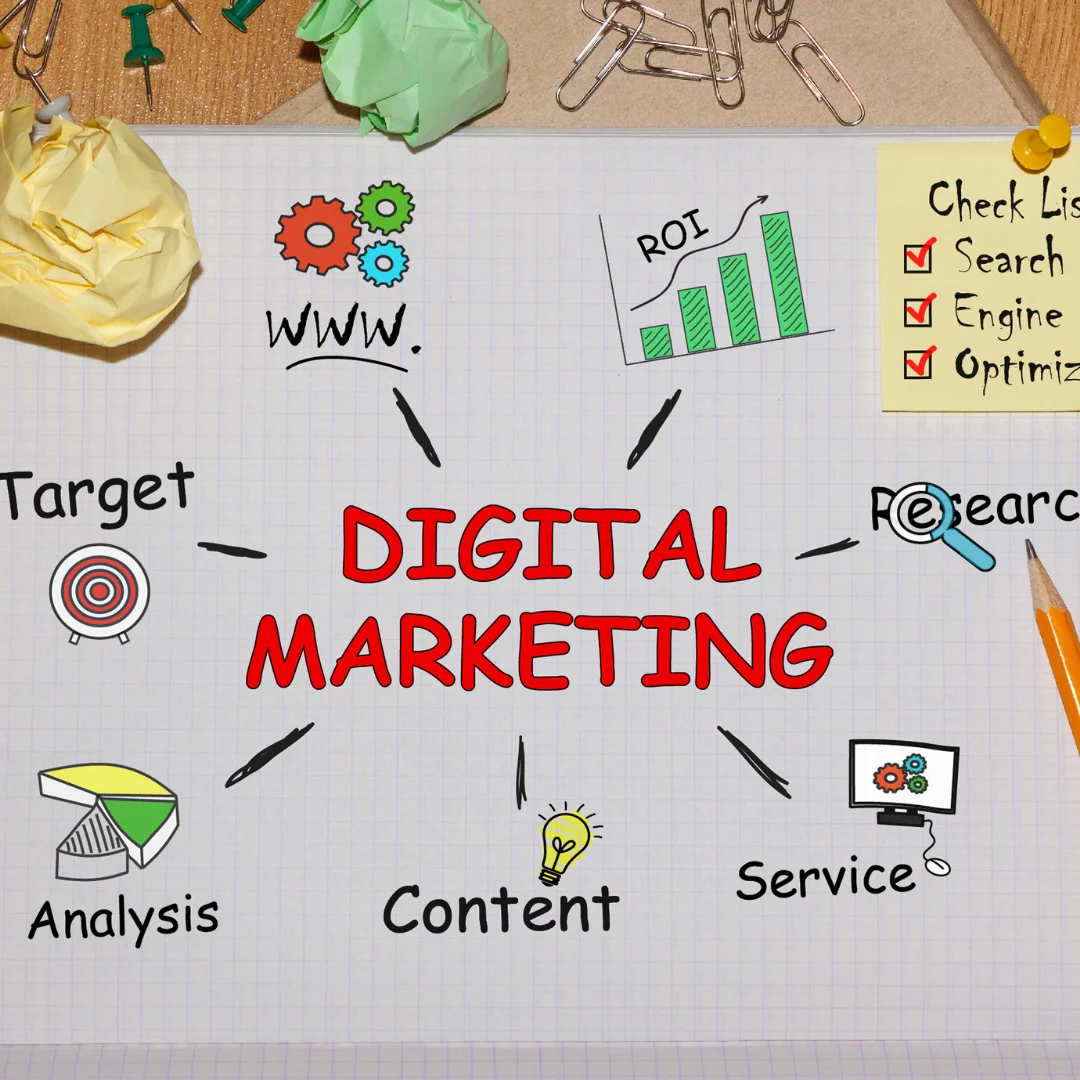For startups aiming to build visibility and connect directly with potential customers, Social Media Marketing (SMM) is invaluable. This guide will walk you through crafting an effective social media strategy, from understanding core SMM principles to choosing the best platforms and tools for efficient management. By following this guide, you’ll learn how to use social media to grow brand awareness, engage customers, and generate measurable business results.
Understanding Social Media Marketing (SMM)

What is Social Media Marketing?
Social Media Marketing (SMM) is the practice of using various social platforms to promote a brand, its products, or services and engage with customers directly. For startups, Social Media Marketing is especially valuable as it’s cost-effective and opens up opportunities to connect with potential customers who are active on these platforms daily.
David Alston, a thought leader in marketing, aptly noted, "Social media is not a media. The key is to listen, engage, and build relationships." His words highlight that social media isn’t just about broadcasting information; it’s about meaningful interactions, fostering loyalty, and building a vibrant community.
At its core, Social Media Marketing empowers startups to compete with established brands by focusing on building relationships, responding to customer needs, and adapting to trends in real-time. Effective Social Media Marketing integrates these core strategies:
The Foundation of Social Media Marketing: Key Principles for Startups
| Principle | Description |
|---|---|
| Listening & Engaging | Actively monitor brand and industry conversations, responding to users to foster trust and connection. |
| Content Creation & Sharing | Develop and distribute content that resonates with your audience, aligns with brand values, and drives engagement. |
| Analyzing & Improving | Use data and analytics to refine strategies, ensuring content and campaigns meet audience needs effectively. |
Listening and Engaging: Building Trust with Your Audience
One of the most important elements of Social Media Marketing is listening and engaging. For startups, social media offers a unique channel to monitor discussions relevant to the brand and interact directly with the community. This two-way interaction isn’t just about responding to comments or questions—it’s a chance to show customers that their voices are valued. Engaging with users promptly can lead to stronger relationships and greater trust, ultimately nurturing a loyal customer base.
Consider platforms like Twitter, where brand conversations are fast-paced, or Instagram, where comments and stories offer direct insights into customer preferences and feedback. By actively engaging on these channels, startups can establish themselves as approachable and customer-centric, even in the early stages of growth.
| Platform | Engagement Opportunity | Purpose |
|---|---|---|
| Responding to tweets, participating in trends | Show responsiveness, establish thought leadership | |
| Answering comments, reposting user-generated content | Build visual brand identity, encourage interaction | |
| Hosting Q&A sessions, community group discussions | Foster a community feel, address questions directly |
Creating and Sharing Content: Showcasing Brand Personality
Social Media Marketing relies on valuable, engaging content that keeps audiences interested and informed. Startups have an advantage here: they can use content to introduce their brand, showcase their personality, and tell their story without the high costs associated with traditional media. Content should be designed to resonate with your target audience and can take many forms, from educational posts to entertaining videos, eye-catching images, or interactive stories.
Types of Content in Social Media Marketing
- Educational Content – Tutorials, guides, and tips related to your industry can position your brand as a trusted resource.
- Promotional Content – Share limited-time offers, new product launches, and discounts to generate interest and drive conversions.
- User-Generated Content – Repost customer reviews, testimonials, and photos to build social proof and community involvement.
- Behind-the-Scenes Content – Show customers the human side of your startup with behind-the-scenes glimpses.
| Content Type | Purpose | Best Platforms |
|---|---|---|
| Educational | Build authority and trust | LinkedIn, Twitter, Facebook |
| Promotional | Drive sales and conversions | Instagram, Facebook, Pinterest |
| User-Generated | Increase authenticity and community involvement | Instagram, Twitter, TikTok |
| Behind-the-Scenes | Show brand personality, humanize the business | Instagram Stories, Facebook Stories |
Analyzing and Improving: Adapting to Audience Needs
For Social Media Marketing to succeed, it’s essential to track the performance of content and campaigns. Startups can use insights from platform analytics to understand which posts resonate most, which times of day yield higher engagement, and what type of content attracts the most interaction. This data helps startups fine-tune their strategies, ensuring that every post or ad is optimized for success.
Most social media platforms offer built-in analytics tools that provide valuable data about engagement, reach, and audience demographics. By studying these metrics, startups can gain a clearer picture of their audience’s needs and refine their Social Media Marketing strategy accordingly.
| Key Metrics to Track | What It Shows | Why It Matters |
|---|---|---|
| Engagement Rate | Level of interaction (likes, comments, shares) | Indicates content relevance and appeal |
| Reach | Number of unique users who see your content | Helps gauge content distribution and visibility |
| Conversion Rate | Percentage of users taking desired actions | Shows effectiveness in achieving campaign goals |
| Follower Growth | Rate at which your audience grows over time | Reflects brand interest and potential market expansion |
With a focus on these metrics, startups can remain agile, adapting content to meet evolving audience expectations. This iterative approach not only boosts engagement but helps in developing more effective campaigns over time.
Why Social Media Marketing is a Game-Changer for Startups
By embracing social media marketing, startups can access tools to build awareness, generate engagement, and foster community. SMM enables young companies to launch with a smaller budget while reaching audiences worldwide. By prioritizing listening, content creation, and data analysis, startups can cultivate an impactful social media presence that grows with their business.
Benefits of Social Media Marketing for Startups

Implementing Social Media Marketing (SMM) can revolutionize the growth and visibility of startups, giving them the power to establish a brand presence without the need for hefty budgets. Here are several major benefits of Social Media Marketing that help startups compete effectively with larger businesses while building a community and fostering loyalty.
Enhanced Brand Visibility
With billions of active users across platforms like Facebook, Instagram, and LinkedIn, social media provides startups an accessible avenue to reach a broad and diverse audience. Unlike traditional advertising channels, Social Media Marketing allows startups to position themselves in front of potential customers in a way that is dynamic and interactive. Through targeted campaigns and engaging content, startups can boost their brand visibility, making it easy for audiences to discover them and remember their offerings.
| Platform | Audience Type | Visibility Strategy |
|---|---|---|
| Millennials, Gen Z | Visual storytelling, reels, interactive stories | |
| Mixed demographics | Community building, targeted ads | |
| Professionals, B2B clients | Thought leadership content, industry networking | |
| TikTok | Younger, trend-driven audience | Viral videos, influencer partnerships |
| Visual planners, hobbyists | Infographics, “how-to” content, visually appealing |
By building a presence on these platforms, startups can attract new followers organically and through ads, increasing awareness and creating a recognizable brand that grows over time.
Cost-Effectiveness
For startups operating on limited budgets, the affordability of Social Media Marketing is a huge advantage. Traditional advertising like TV commercials or print ads requires substantial capital, which isn’t always feasible for new businesses. In contrast, social media platforms offer affordable and scalable advertising solutions that allow startups to reach a well-defined audience with minimal investment. Many platforms, such as Facebook and Instagram, provide low-cost ad campaigns that can be adjusted in real-time, allowing startups to optimize their strategies without breaking the bank.
| Platform | Average Cost per Click (CPC) | Budget-Friendly Features |
|---|---|---|
| $0.97 – $1.72 | Detailed targeting, flexible budget options | |
| $1.25 – $2.00 | Story ads, carousel ads | |
| $5.26 – $6.50 | Precise B2B targeting, lead generation forms | |
| $0.38 – $0.78 | Promoted tweets, trending topics targeting | |
| TikTok | $0.10 – $1.00 | In-feed ads, branded hashtag challenges |
Gary Vaynerchuk, a leading voice in digital marketing, explains, “Brands using social media are like businesses giving people a place to go, to meet up, chat, and learn. It’s all about how you’re using it to build real connections, not just to pitch.” His perspective perfectly aligns with the needs of startups, emphasizing the value of creating genuine connections on social platforms without a heavy financial burden.
Direct Communication
Social Media Marketing allows startups to communicate directly with their audience, providing an instant feedback loop that is essential for growth. Real-time engagement through comments, direct messages, and live chat features enables startups to respond to customer inquiries, gather valuable insights, and address concerns immediately. This instant accessibility fosters a stronger relationship with customers and enhances trust in the brand, making customers more likely to return and recommend the brand to others.
| Direct Communication Tool | Platform | Purpose |
|---|---|---|
| Direct Messages (DMs) | Instagram, Facebook | Private conversation, customer support |
| Comments Section | All platforms | Public engagement, customer insights |
| Live Videos | Instagram, TikTok, Facebook | Real-time interaction, Q&A sessions |
| Stories (Polls, Questions) | Instagram, Facebook | Collect feedback, increase engagement |
The real-time responsiveness of Social Media Marketing empowers startups to make a lasting impression, build trust, and nurture customer loyalty right from the start.
Improved Brand Visibility
SMM helps startups stand out by enhancing brand visibility and recognition. Regular posting and engagement across social media increase the likelihood of brand recall when potential customers make purchasing decisions. The strategic use of hashtags, collaborations, and sharing user-generated content can all contribute to improved visibility in a way that is both engaging and meaningful.
| Brand Visibility Strategy | Example Action | Result |
|---|---|---|
| Hashtags | Use relevant hashtags on Instagram, Twitter | Increased discoverability |
| Influencer Partnerships | Collaborate with industry influencers | Boosted brand credibility and visibility |
| User-Generated Content | Repost customer photos, reviews | Builds social proof, engages audience |
| Giveaways and Contests | Run a contest to encourage engagement | Draws in new followers, strengthens brand recall |
For startups, maximizing brand visibility is crucial for growth, and Social Media Marketing is a key tool for staying visible and relevant within the industry.
Increased Customer Loyalty
Regular interaction and engagement foster a sense of community and loyalty among customers. Social Media Marketing enables startups to engage customers on a personal level, building relationships that go beyond mere transactions. By offering valuable content, listening to customer feedback, and responding to inquiries, startups create a positive brand experience that encourages repeat interactions and long-term loyalty.
| Loyalty-Building Strategy | Description | Benefit |
|---|---|---|
| Personalized Responses | Tailor responses to individual comments or messages | Makes customers feel valued |
| Exclusive Offers for Followers | Offer special discounts or perks for social followers | Encourages following and loyalty |
| Community Building | Create a Facebook group or LinkedIn page | Builds a loyal community, fosters discussion |
| Celebrating Customer Milestones | Acknowledge loyal customers on their anniversaries | Deepens the customer relationship |
Targeted Advertising
One of the standout benefits of Social Media Marketing is its robust targeting options. Startups can use social media platforms to create highly specific ads that reach audiences based on demographics, location, interests, and even past online behavior. This targeted advertising ensures that startups aren’t wasting resources on broad, unfocused campaigns but are instead reaching those who are most likely to be interested in their products or services.
| Ad Targeting Option | Description | Platform |
|---|---|---|
| Location-Based Targeting | Targets users in specific regions or cities | Facebook, Instagram |
| Demographic Targeting | Targets based on age, gender, and income | LinkedIn, Facebook |
| Interest Targeting | Targets based on users’ hobbies and preferences | Instagram, Twitter |
| Lookalike Audience | Targets people similar to existing customers | Facebook, LinkedIn |
| Behavioral Targeting | Targets users based on online behavior and purchase history | Facebook, Instagram |
This level of precision helps startups make the most of their budgets by delivering ads that are relevant to users’ preferences, ultimately leading to higher conversion rates.
Key Benefits of Social Media Marketing for Startups
| Benefit | Description |
|---|---|
| Cost-Effectiveness | Social platforms offer scalable, budget-friendly advertising options that fit a startup’s budget. |
| Real-Time Interaction | Direct communication through comments, messages, and live features enhances customer engagement and trust. |
| Improved Brand Visibility | Consistent, strategic posting and ads increase brand awareness, helping startups attract customers. |
| Increased Customer Loyalty | Personalized engagement cultivates loyalty, encouraging repeat business and referrals. |
| Targeted Advertising | Platforms enable highly specific ad targeting, ensuring startups reach the most relevant audiences. |
Social Media Marketing provides a unique opportunity for startups to build an authentic, loyal customer base. By utilizing SMM’s cost-effective strategies and direct communication tools, startups can establish a strong brand identity that grows as their business expands.
Key Components of an Effective Social Media Marketing Strategy

A successful Social Media Marketing strategy requires thoughtful planning and clear direction. By focusing on key components, businesses can develop a structured approach that effectively reaches their audience and achieves measurable outcomes. Here’s a breakdown of the core components to consider for impactful Social Media Marketing.
1. Setting Clear Goals
Setting specific, measurable, achievable, relevant, and time-bound (SMART) goals is fundamental to success in Social Media Marketing. These goals provide a clear target and ensure all efforts are purpose-driven, making it easier to track progress and adjust strategies along the way.
Common Social Media Marketing goals include:
- Increasing Brand Awareness: Aiming to grow followers, likes, and shares to boost visibility.
- Generating Leads: Using targeted ads or lead magnets to capture new potential customers.
- Boosting Website Traffic: Driving followers to the website through engaging content and strong calls-to-action.
| Goal | Definition | Example |
|---|---|---|
| Increase Brand Awareness | Enhance brand visibility and recognition | Achieve 1,000 new followers in 3 months |
| Generate Leads | Attract potential customers through social ads | Collect 100 new email sign-ups per month |
| Boost Website Traffic | Drive visitors to the company’s website | Increase site traffic by 20% from social referrals |
Setting SMART goals allows businesses to stay focused on achieving specific outcomes rather than broad objectives, making it easier to evaluate the effectiveness of their Social Media Marketing strategies.
2. Identifying and Understanding Your Target Audience
Knowing who your target audience is—and understanding their preferences—enables a brand to tailor its Social Media Marketing approach effectively. Research into audience demographics, interests, and online behaviors can reveal insights into what types of content and which platforms will engage them most.
To understand your target audience better:
- Use Audience Insights: Social media platforms like Facebook and Instagram offer insights tools that show demographics, interests, and engagement patterns.
- Analyze Competitors: Examining competitors’ audiences can reveal untapped segments and help avoid overcrowded approaches.
- Surveys and Polls: Directly ask your current audience about their content preferences, challenges, and what they’d like to see more of.
| Audience Type | Preferred Content | Ideal Platform |
|---|---|---|
| Millennials | Educational and user-generated content | Instagram, YouTube |
| Gen Z | Video, interactive content | TikTok, Snapchat |
| Professionals | Industry news, thought leadership | |
| Parents | Tips, family-oriented advice | Facebook, Pinterest |
Understanding the audience’s content preferences ensures that Social Media Marketing efforts are directed toward content that resonates, increasing the likelihood of engagement and brand loyalty.
3. Selecting the Right Platforms
Each social media platform attracts different audiences and offers distinct features. Choosing the right platforms is essential to ensuring your Social Media Marketing reaches the intended audience effectively. While a multi-platform strategy might seem appealing, it’s often more effective for startups and small businesses to focus on a few platforms where their target audience is most active.
Overview of Popular Platforms and Their Strengths
- Facebook: Ideal for general awareness; great for community-building with a mixed demographic.
- Instagram: Suits brands with strong visual elements; popular among younger audiences (Millennials and Gen Z).
- LinkedIn: Primarily for B2B and professional networking, sharing industry knowledge, and thought leadership.
- TikTok: Best for engaging younger audiences through creative, short-form videos.
- Twitter: Suits brands focused on real-time updates and quick engagement with trending topics.
| Platform | Primary Audience | Best for | Content Type |
|---|---|---|---|
| All age groups | Community building, ads | Stories, ads, video content | |
| 18-34 | Visual storytelling, influencer marketing | Photos, reels, IGTV | |
| Professionals, B2B | Networking, thought leadership | Articles, posts, video | |
| TikTok | 16-24 | Viral, interactive, trendy content | Short-form video |
| Hobbyists, planners | Visual guides, lifestyle and DIY | Pins, infographics |
Selecting the right platforms ensures that Social Media Marketing efforts are directed where they will have the greatest impact, helping startups maximize their reach and engagement.
4. Creating a Content Strategy
Content is the core of any Social Media Marketing strategy. A well-thought-out content strategy that reflects a brand’s mission, voice, and goals is vital for engaging and retaining an audience. Ideally, content should be varied, providing value without becoming monotonous. Using a mix of educational, entertaining, and promotional content creates a balanced approach that appeals to different audience needs.
Key Types of Social Media Content:
- Educational Content: Provides valuable information, such as tips, how-to guides, and tutorials, helping to establish authority.
- Entertaining Content: Memes, stories, or videos that engage audiences and encourage sharing.
- Promotional Content: Posts directly promoting products, services, or offers, with clear calls-to-action.
| Content Type | Description | Example |
|---|---|---|
| Educational | Informative, value-driven content | How-to guides, infographics |
| Entertaining | Engages users through humor or trending topics | Memes, interactive polls |
| Promotional | Direct product or service promotion | Sale announcements, special offers |
| User-Generated | Content created by customers or fans | Customer reviews, tagged photos |
| Behind-the-Scenes | Provides an insider look at the brand | Office tours, team introductions |
Building a content calendar helps organize and schedule posts, ensuring a consistent presence on social media and making it easier to maintain a balanced mix of content types. Additionally, tracking the performance of different content types offers valuable insights into what resonates best with the audience.
5. Measuring and Analyzing Performance
To make sure Social Media Marketing efforts are impactful, businesses need to track key performance metrics regularly. These metrics help assess whether the strategy is achieving its goals and offer insights for continuous improvement.
Key Social Media Metrics to Track:
- Engagement Rate: Measures how actively the audience is interacting with the content through likes, shares, comments, and reactions.
- Reach and Impressions: Shows the number of people who see the content and the total number of times it is displayed.
- Conversion Rate: Indicates the percentage of social media users who took a desired action, such as signing up for a newsletter or making a purchase.
- Click-Through Rate (CTR): Measures how often users clicked on a link within a post or ad, indicating the effectiveness of the call-to-action.
| Metric | Description | What it Measures |
|---|---|---|
| Engagement Rate | Total engagement divided by total reach | Audience interest and interaction |
| Reach and Impressions | Reach is unique viewers; impressions are views | Content visibility and effectiveness |
| Conversion Rate | Percentage of users who completed a goal action | Effectiveness in driving actions |
| CTR | Clicks on links divided by impressions | Effectiveness of call-to-action |
Regularly analyzing these metrics allows businesses to fine-tune their Social Media Marketing strategy based on what’s working and what needs adjustment. Using this data, brands can continuously improve their approach and ensure they are maximizing the impact of their social media efforts.
Popular Social Media Platforms for Startups

Choosing the right platforms is essential to building an effective Social Media Marketing strategy. While many platforms are popular, each one serves a unique purpose and audience. Here’s an in-depth look at the top social media platforms that startups can leverage for greater visibility, engagement, and brand growth.
| Platform | User Base (Global) | Best For | Tips for Startups |
|---|---|---|---|
| 2.9 billion active users | Brand awareness, community building | Run targeted ads; engage with groups and live videos. | |
| 1.4 billion active users | Visual storytelling, younger users | Use Stories, Reels, and polls to show brand personality | |
| 875 million active users | B2B networking, thought leadership | Share articles; connect with industry influencers. | |
| 450 million active users | Real-time engagement, customer support | Use trending hashtags; maintain an active presence. | |
| TikTok | 1 billion active users | Creative, viral content | Participate in challenges; use popular music tracks. |
Facebook: The Go-To Social Media Marketing Platform for Brand Awareness and Community Building
Facebook remains a cornerstone in Social Media Marketing due to its extensive user base, varied demographics, and versatile features. For startups, Facebook is a valuable platform for establishing a broad reach, building a community, and increasing brand visibility.
Why Facebook is Ideal for Startups:
- User Base: With 2.9 billion active users, Facebook’s audience spans multiple demographics, making it a suitable platform for brands targeting a wide range of ages.
- Best For: Brand awareness, customer engagement, community building, and running cost-effective ads.
Tips for Leveraging Facebook:
- Targeted Ads: Facebook’s ad platform allows precise targeting based on demographics, interests, and behaviors. Startups can create ads that reach users most likely to engage with their products or services.
- Engage in Community Groups: Joining relevant groups allows startups to interact with a like-minded audience. Participating in discussions and sharing valuable insights can organically build brand recognition.
- Use Stories and Live Videos: Engage followers by sharing real-time content, including live product demonstrations, Q&A sessions, and behind-the-scenes insights.
| Content Type | Example | Why It Works |
|---|---|---|
| Targeted Ads | Sponsored posts, video ads | Increases visibility among targeted users |
| Community Groups | Joining local or niche interest groups | Builds brand credibility |
| Stories and Live | Real-time updates, behind-the-scenes | Creates authenticity and engagement |
Instagram: Visual Storytelling for a Younger, Engaged Audience
Instagram is a visually-driven platform that is especially popular among younger users, with the majority falling between the ages of 18 and 34. Startups in lifestyle, fashion, or visual-heavy industries find Instagram highly effective for Social Media Marketing.
Why Instagram is Ideal for Startups:
- User Base: With 1.4 billion active users, Instagram’s audience is primarily young and highly engaged.
- Best For: Visual storytelling, influencer collaborations, and promoting aesthetically appealing products.
Tips for Leveraging Instagram:
- Use Stories and Reels: Instagram Stories allow brands to share time-sensitive, casual content. Reels, on the other hand, are ideal for creating short, engaging videos to capture user attention.
- Leverage Influencer Partnerships: Working with influencers helps startups reach new audiences and build credibility through trusted voices.
- Polls and Interactive Features: Startups can use Instagram’s interactive features, like polls and question stickers, to engage followers and gain insights into their preferences.
| Content Type | Example | Why It Works |
|---|---|---|
| Stories | Daily updates, limited-time offers | Keeps followers engaged with fresh content |
| Reels | Short, fun videos | Increases reach through algorithmic favor |
| Influencer Partnerships | Sponsored posts | Builds trust through credible voices |
LinkedIn: Building Professional Networks and B2B Marketing
LinkedIn is the go-to platform for B2B startups and those looking to establish a professional reputation. Known for its industry-focused user base, LinkedIn provides a unique opportunity to connect with professionals, potential clients, and industry influencers.
Why LinkedIn is Ideal for Startups:
- User Base: With over 875 million users, LinkedIn is a platform where decision-makers and professionals frequently engage.
- Best For: B2B networking, thought leadership, and industry insights.
Tips for Leveraging LinkedIn:
- Publish Thought Leadership Content: Share original articles or insights on industry trends to establish your startup as an expert in the field.
- Build Connections with Influencers: Connect with industry leaders and participate in professional discussions to build your network.
- Use LinkedIn Ads for Lead Generation: LinkedIn offers targeted ads specifically designed to generate leads from a professional audience.
| Content Type | Example | Why It Works |
|---|---|---|
| Thought Leadership | Articles, case studies | Positions brand as an authority |
| Influencer Connections | Comments, shared posts | Builds visibility and network growth |
| Lead Generation Ads | Sponsored messages | Targets high-value, professional audiences |
Twitter: Real-Time Updates and Customer Engagement
Twitter is a powerful platform for startups to share real-time updates, news, and engage directly with customers. Its fast-paced nature makes it ideal for customer service, quick announcements, and participating in trending conversations.
Why Twitter is Ideal for Startups:
- User Base: 450 million active users, with a broad range of demographics and interests.
- Best For: Real-time engagement, customer service, and staying up-to-date with trends.
Tips for Leveraging Twitter:
- Participate in Trending Hashtags: Using trending hashtags can boost visibility and increase engagement. Jumping into relevant conversations keeps the brand current and visible.
- Engage Through Customer Support: Twitter is often used for direct customer service. Responding quickly to inquiries and issues can boost customer satisfaction.
- Run Polls for Engagement: Twitter polls are a fun way to interact with followers and gain insights into audience preferences.
| Content Type | Example | Why It Works |
|---|---|---|
| Trending Hashtags | #MondayMotivation, #TechNews | Increases brand visibility |
| Customer Support | Answering queries, handling issues | Builds a responsive brand image |
| Polls | Fun or informative polls | Engages users and provides insights |
TikTok: Viral, Creative Content for Brand Discovery
TikTok has rapidly become a hub for creative, short-form video content. It’s particularly popular among Gen Z, and its algorithm-driven format gives startups the potential for viral success even with smaller followings.
Why TikTok is Ideal for Startups:
- User Base: 1 billion active users, primarily younger audiences (16-24).
- Best For: Creative, viral content and brand discovery.
Tips for Leveraging TikTok:
- Participate in Trending Challenges: Jump on popular challenges to reach a wider audience. TikTok’s trend-based nature means that participating in viral challenges can lead to increased visibility.
- Use Popular Sounds: TikTok’s algorithm often favors content with popular sounds. Startups can incorporate trending sounds or songs to align with user preferences.
- Collaborate with Micro-Influencers: Partnering with influencers who have a strong connection with your target audience can enhance credibility and reach.
| Content Type | Example | Why It Works |
|---|---|---|
| Trending Challenges | #DanceChallenge, #GlowUp | Increases reach through viral participation |
| Popular Sounds | Background music in videos | Favors content discovery |
| Micro-Influencer Collabs | Product placements, reviews | Builds trust through relatable influencers |
Challenges in Social Media Marketing for Startups

Social media platforms provide startups with powerful opportunities to reach new audiences, increase brand awareness, and engage customers. However, achieving these goals can be difficult due to several unique challenges startups face, such as content saturation, changing algorithms, and resource limitations.
Content Saturation: Breaking Through the Noise
The sheer volume of content shared on social media each day can make it challenging for startups to stand out. Established brands often dominate, and startups must work harder to get noticed by their target audience.
Why Content Saturation is a Challenge To Social Media Marketing
Social media has become a crowded space, with millions of posts, stories, and videos uploaded daily. The competition for user attention means that content quality, uniqueness, and timing are more critical than ever for startups to make an impact.
Social Media Marketing Strategies to Overcome Content Saturation
- Focus on Authenticity: Users are drawn to genuine, relatable content. Showcasing a behind-the-scenes look or sharing real customer stories can resonate with viewers and build trust.
- Use Visual Storytelling: Visuals are powerful attention-grabbers, so high-quality images, videos, and infographics can help content stand out in users’ feeds.
- Leverage User-Generated Content: Encourage customers to create content about their experiences with your product or service. This not only increases credibility but also helps you reach new audiences.
| Strategy | Description | Benefits |
|---|---|---|
| Authenticity | Showcase real stories and experiences | Builds trust and emotional connection |
| Visual Storytelling | Use images, videos, and infographics | Engages users visually and stands out in feeds |
| User-Generated Content | Encourage customers to share their stories | Expands reach and adds social proof |
Algorithm Shifts: Navigating Constant Changes
Social media platforms regularly update their algorithms, affecting how content is prioritized in users’ feeds. For startups, these changes can drastically impact organic reach and engagement rates.
Why Algorithm Shifts are a Challenge In Social Media Marketing
Algorithms are complex and often prioritize content from friends, family, or sponsored posts over business content. For a startup with a smaller audience and limited budget, staying visible in the feed can be difficult, especially when the algorithm favors posts from well-established brands.
Social Media Marketing Strategies to Adapt to Algorithm Changes
- Stay Updated on Platform Changes: Regularly follow each platform’s blog or press releases to stay informed about any algorithm updates. This will help you adjust your strategies proactively.
- Experiment with New Features: Social media platforms often prioritize content that uses their latest features. Try out Reels, Stories, or live streaming if available on the platform you’re using.
- Focus on Engagement Metrics: Likes and shares matter, but comments, saves, and meaningful interactions tend to be favored by algorithms. Craft content that encourages active engagement and genuine interaction.
| Strategy | Description | Benefits |
|---|---|---|
| Stay Updated | Follow platform updates | Allows proactive adjustment to content strategy |
| Experiment with Features | Use new tools like Stories or live videos | Increases reach as platforms promote new tools |
| Boost Engagement Metrics | Encourage comments and shares | Prioritizes content in feeds due to high engagement |
Resource Constraints: Maximizing Impact on a Budget
Many startups operate with limited financial and human resources, which can restrict their ability to create and distribute high-quality content on multiple platforms.
Why Resource Constraints are a Challenge To Social Media Marketing
Without a dedicated social media team or a large advertising budget, it can be challenging for startups to maintain a consistent, impactful social media presence. Content creation, audience engagement, and analytics all require time and skill, which may be in short supply for startups.
Social Media Marketing Strategies to Maximize Resources
- Prioritize Key Platforms: Instead of spreading efforts thinly across multiple platforms, identify which platforms are most relevant to your audience and focus on those. For example, a B2B startup might prioritize LinkedIn over Instagram.
- Repurpose Content: Save time by repurposing content across platforms. For example, turn a blog post into a series of social media posts or an infographic.
- Utilize Free Tools and Resources: There are numerous free tools available for creating visuals (Canva), scheduling posts (Buffer), and tracking performance (Google Analytics). Leverage these to streamline and improve your social media efforts.
| Strategy | Description | Benefits |
|---|---|---|
| Prioritize Key Platforms | Focus on 1-2 main platforms | Saves resources while maximizing audience reach |
| Repurpose Content | Adapt content across different formats | Reduces content creation time |
| Free Tools | Use tools for visuals, scheduling, analytics | Helps maintain a polished presence affordably |
Building a Loyal Audience: Overcoming the Initial Visibility Barrier
Startups often start with little to no following, which can make it hard to gain traction on social media. Without an established audience, gaining visibility and fostering community engagement can be slow.
Why Building an Audience is a Challenge In Social Media Marketing
Without a loyal following, posts may not get enough engagement to be prioritized by algorithms. This initial barrier can be discouraging, as early social media growth can be slow without a large marketing budget or established brand recognition.
Social Media Marketing Strategies to Build a Loyal Audience
- Engage Actively with Followers: Responding to comments, asking questions, and acknowledging followers by name can foster a sense of community and loyalty.
- Partner with Micro-Influencers: Collaborate with micro-influencers who resonate with your target audience. These influencers often have strong, engaged followers and are more affordable than top-tier influencers.
- Host Contests and Giveaways: Contests and giveaways can be an effective way to increase visibility and attract new followers. Make sure the prize is relevant to your product or service to ensure you’re attracting interested followers.
| Strategy | Description | Benefits |
|---|---|---|
| Engage Actively | Respond to comments and DMs | Builds community and loyalty |
| Partner with Micro-Influencers | Collaborate with small-scale influencers | Boosts reach affordably |
| Contests and Giveaways | Host engaging activities | Attracts new followers and increases engagement |
Measuring Success: Tracking and Understanding Key Metrics
Measuring the effectiveness of social media marketing efforts is essential to determine ROI, but it can be difficult for startups to know which metrics to prioritize and how to interpret them.
Why Measuring Success is a Challenge
With a wide array of metrics available, it can be overwhelming to decide what data points are meaningful. Startups may also struggle to connect social media metrics to tangible business outcomes, making it hard to justify continued investment in Social Media Marketing.
Social Media Marketing Strategies to Track and Interpret Key Metrics
- Set Clear Objectives: Define what success looks like on each platform. Whether it’s brand awareness, lead generation, or engagement, having specific goals helps in tracking relevant metrics.
- Focus on Actionable Metrics: Vanity metrics like follower count can be misleading. Instead, focus on metrics that provide actionable insights, such as engagement rate, click-through rate, and conversion rate.
- Use Analytics Tools: Most social media platforms offer built-in analytics to help track performance. Use these tools to monitor progress and identify areas for improvement.
| Metric | Description | Importance |
|---|---|---|
| Engagement Rate | Ratio of interactions to followers | Shows audience interest and involvement |
| Click-Through Rate (CTR) | Clicks divided by impressions | Indicates effectiveness of CTAs |
| Conversion Rate | Actions taken after clicking (e.g., sign-ups) | Measures ROI and campaign effectiveness |
Effective Social Media Marketing Strategies for Engaging Customers on Social Media

Effectively engaging customers is essential for startups and established businesses alike, as it builds brand loyalty, strengthens customer relationships, and drives conversions. Here are several strategies within Social Media Marketing that can create meaningful customer interactions.
User-Generated Content (UGC): Leveraging Authentic Customer Experiences
User-Generated Content (UGC) is a powerful tool for social media engagement because it builds trust and credibility by showing real customers using your products or services. People are often more likely to trust other users’ experiences than direct brand messaging.
Why UGC Matters for Social Media Marketing
UGC creates social proof, making your brand more relatable and trustworthy. Potential customers who see others enjoying your product are more likely to be persuaded to try it themselves. Additionally, UGC can serve as a source of fresh, authentic content that helps diversify your brand’s social media feed.
How to Encourage User-Generated Content
- Run a Hashtag Campaign: Create a unique, branded hashtag and encourage followers to use it when posting about their experience with your product. This makes it easier to gather UGC and promotes visibility as users share the hashtag.
- Host a Photo or Video Contest: Competitions are a great way to boost engagement and gather UGC. Ask customers to post a photo or video of themselves with your product for a chance to win a prize.
- Feature Customer Testimonials: Repost user-generated reviews or testimonials on your social media accounts to show appreciation and highlight satisfied customers.
| UGC Strategy | Description | Benefit |
|---|---|---|
| Hashtag Campaign | Create a branded hashtag | Increases visibility and social proof |
| Photo or Video Contest | Encourage creative UGC submissions | Boosts engagement and broadens content variety |
| Customer Testimonials | Repost positive reviews or testimonials | Builds credibility and trust |
Live Sessions and Q&A: Engaging with Real-Time Interactions
Hosting live sessions is a highly engaging tactic within Social Media Marketing, as it allows for real-time connection and interaction with your audience. Whether it’s a product launch, Q&A session, or educational webinar, live content keeps followers interested and offers direct access to your brand.
Why Live Sessions Are Effective for Engagement
Live sessions offer authenticity and immediacy, allowing followers to engage directly with your brand representatives and get instant responses to their questions. This direct line to the brand strengthens the connection and builds trust.
Types of Live Sessions for Startups
- Product Demos or Launches: Showcasing a new product live enables you to highlight its features, address questions, and generate excitement in real-time.
- Q&A Sessions: Allowing followers to ask questions on social media gives them an opportunity to receive tailored information, increasing customer satisfaction and brand transparency.
- Educational Webinars: Hosting live educational content on industry topics adds value and positions your brand as a knowledgeable authority in your field.
| Live Session Type | Description | Benefit |
|---|---|---|
| Product Demos | Showcase product features in real-time | Builds excitement and addresses questions |
| Q&A Sessions | Answer customer queries live | Improves transparency and engagement |
| Educational Webinars | Share knowledge on industry topics | Establishes brand authority and adds value |
Personalized Interactions: Building Individual Connections
Social Media Marketing thrives on personalization, especially when it comes to responding to comments, messages, and reviews. Personalized interactions not only make customers feel valued but also foster a sense of connection and loyalty.
Why Personalized Interactions Matter
Responding to customers personally shows that your brand values its followers and is willing to invest time in individual interactions. This strategy humanizes the brand and builds a stronger, more trustworthy relationship with your audience.
Ways to Personalize Interactions
- Directly Address Followers: Use followers’ names when replying to comments or messages to add a personal touch.
- Acknowledge User Concerns and Feedback: Whether positive or negative, responding thoughtfully to feedback shows that the brand values customers’ opinions.
- Send Personalized Thank-You Messages: For milestones such as a customer’s first purchase or brand anniversary, sending a thank-you message or small gift can create lasting goodwill.
| Personalization Method | Description | Benefit |
|---|---|---|
| Address Followers by Name | Use names in responses | Builds a personal connection and loyalty |
| Respond to Feedback | Acknowledge customer comments and concerns | Shows customers that their opinions matter |
| Thank-You Messages | Send gratitude notes for milestones | Strengthens positive customer relationships |
Utilizing Stories for Daily Engagement
Social media platforms like Instagram and Facebook offer “Stories” as a format for sharing time-sensitive, engaging content. Stories are short, casual posts that can create a consistent touchpoint with followers, encouraging daily engagement without the pressure of polished, permanent posts.
Why Stories Are Effective for Engagement
Stories are ephemeral, meaning they disappear after 24 hours. This short lifespan creates a sense of urgency for followers to check your content regularly. Additionally, Stories offer interactive features like polls, question stickers, and quizzes, which increase engagement.
Types of Story Content to Share
- Behind-the-Scenes Moments: Give followers a glimpse of your company’s day-to-day activities, creating a sense of familiarity and closeness.
- Interactive Polls and Q&As: Engage followers by using polls or Q&A stickers to gather opinions, answer questions, or crowdsource ideas.
- Announcements and Limited-Time Offers: Use Stories to announce special promotions, sales, or events to keep followers coming back for updates.
| Story Content Type | Description | Benefit |
|---|---|---|
| Behind-the-Scenes | Show daily operations or team activities | Builds authenticity and relatability |
| Interactive Polls and Q&As | Ask questions and share answers | Increases engagement and follower involvement |
| Limited-Time Offers | Announce exclusive offers or sales | Creates urgency and drives immediate action |
Polls, Contests, and Giveaways: Driving Engagement Through Fun
Polls, contests, and giveaways are excellent methods for increasing engagement, attracting new followers, and promoting products in a fun and interactive way. These techniques encourage users to participate actively, which can boost your visibility on social media.
Why Polls, Contests, and Giveaways Work
These activities create excitement, as followers have the chance to win something or have their opinions heard. Moreover, they often result in shares, likes, and comments, which increases your brand’s exposure.
How to Run Engaging Polls, Contests, and Giveaways
- Use Polls for Feedback: Polls help you gauge customer preferences and gather insights. For example, a clothing brand might ask followers to vote on their favorite new design.
- Host Contests with Clear Rules: Keep the contest rules simple to encourage more participation. Specify the prize, entry method, and deadline clearly.
- Offer Irresistible Prizes: Make the reward relevant to your brand. Offering a popular product or a discount encourages followers to participate and helps ensure that participants have a genuine interest in your business.
| Engagement Strategy | Description | Benefit |
|---|---|---|
| Polls | Gather feedback or preferences | Involves followers in decision-making |
| Contests | Host activities with a prize for engagement | Drives interaction and builds anticipation |
| Giveaways | Offer a popular product as a reward | Attracts new followers and generates buzz |
Utilizing Influencer Partnerships to Expand Reach As A Social Media Marketing Strategy
Partnering with influencers is a tried-and-true Social Media Marketing strategy that startups can use to expand their reach. Influencers with engaged audiences can boost your brand visibility, build credibility, and attract followers who may not have discovered your brand otherwise.
Why Influencer Partnerships Are Effective
Influencers often have strong, loyal followers who trust their recommendations. By leveraging this trust, startups can increase brand credibility and reach potential customers who are likely to be interested in their product.
Tips for Effective Influencer Partnerships
- Choose Relevant Influencers: Partner with influencers whose audience aligns with your target demographic. A smaller, niche influencer may be more effective than a large, general one if their followers fit your ideal customer profile.
- Create Authentic Content: Instead of scripted ads, allow influencers to create their own content that authentically represents their voice and perspective.
- Offer Value to Followers: Include a discount code or special offer to encourage the influencer’s followers to engage with your brand.
| Influencer Partnership | Description | Benefit |
|---|---|---|
| Relevant Influencer Choice | Align with niche influencers | Ensures that followers are likely interested |
| Authentic Content Creation | Allow influencers creative freedom | Builds authenticity and credibility |
| Offer Value | Provide discounts or offers | Encourages followers to try your brand |
Tools and Techniques for Streamlining Your Social Media Marketing Process

When it comes to social media marketing, managing multiple social channels can be overwhelming, but using the right tools can streamline the process:
| Tool | Features | Best For |
|---|---|---|
| Buffer | Scheduling, analytics, and reporting | Small to medium-sized startups |
| Hootsuite | Content calendar, social listening, and analytics | Comprehensive social media management |
| Sprout Social | Team collaboration, customer engagement, and analytics | Medium to larger teams needing collaboration |
| Canva | Easy-to-use design templates | Creating quick, visually appealing content |
| Later | Instagram-focused scheduling and visual planning | Startups with a heavy Instagram presence |
Integrating Social Media Marketing with Other Marketing Efforts for Maximum Impact
For a holistic digital marketing approach, integrating Social Media Marketing (SMM) with other strategies can enhance results:
- SEO Synergy: Share blog posts or content that drives organic search traffic. Engaging content on social media can also boost your website’s SEO by generating backlinks and visitor traffic.
- Email Marketing: Social media is a great place to promote lead magnets like free resources, which can then lead to building an email list for more direct marketing.
- Paid Advertising: Social media advertising can complement organic reach by targeting specific demographics, enhancing campaign visibility.
Latest Trends in Social Media Marketing That Startups Should Embrace
To stay competitive, startups need to embrace current trends in Social Media Marketing:
- Influencer Marketing: Partnering with influencers allows brands to reach engaged audiences. Influencers can help introduce products in authentic and relatable ways.
- Ephemeral Content: Platforms like Instagram Stories and Snapchat feature temporary content, which is popular among younger audiences for its real-time, engaging nature.
- Short-Form Video: Platforms like TikTok and Instagram Reels cater to the growing popularity of bite-sized video content, ideal for showcasing products, tutorials, and brand personality.
Conclusion
For startups, Social Media Marketing (SMM) is not just about promoting products but creating meaningful interactions with customers. By applying the strategies, choosing the right platforms, and using the tools and trends discussed here, startups can effectively establish a social presence that builds brand awareness, engages audiences, and drives growth.
📚💡Extra Resources: Are you having a hard time converting your followers and readers into actual paying customers? Do you keep posting content on every social media platform but end up with next to zero engagement and conversions? The simplest solution is to master content creation that attracts and engages customers and converts them seamlessly into paying clients. Learn how to use proven frameworks to streamline content creation. To learn more, [Click here].





